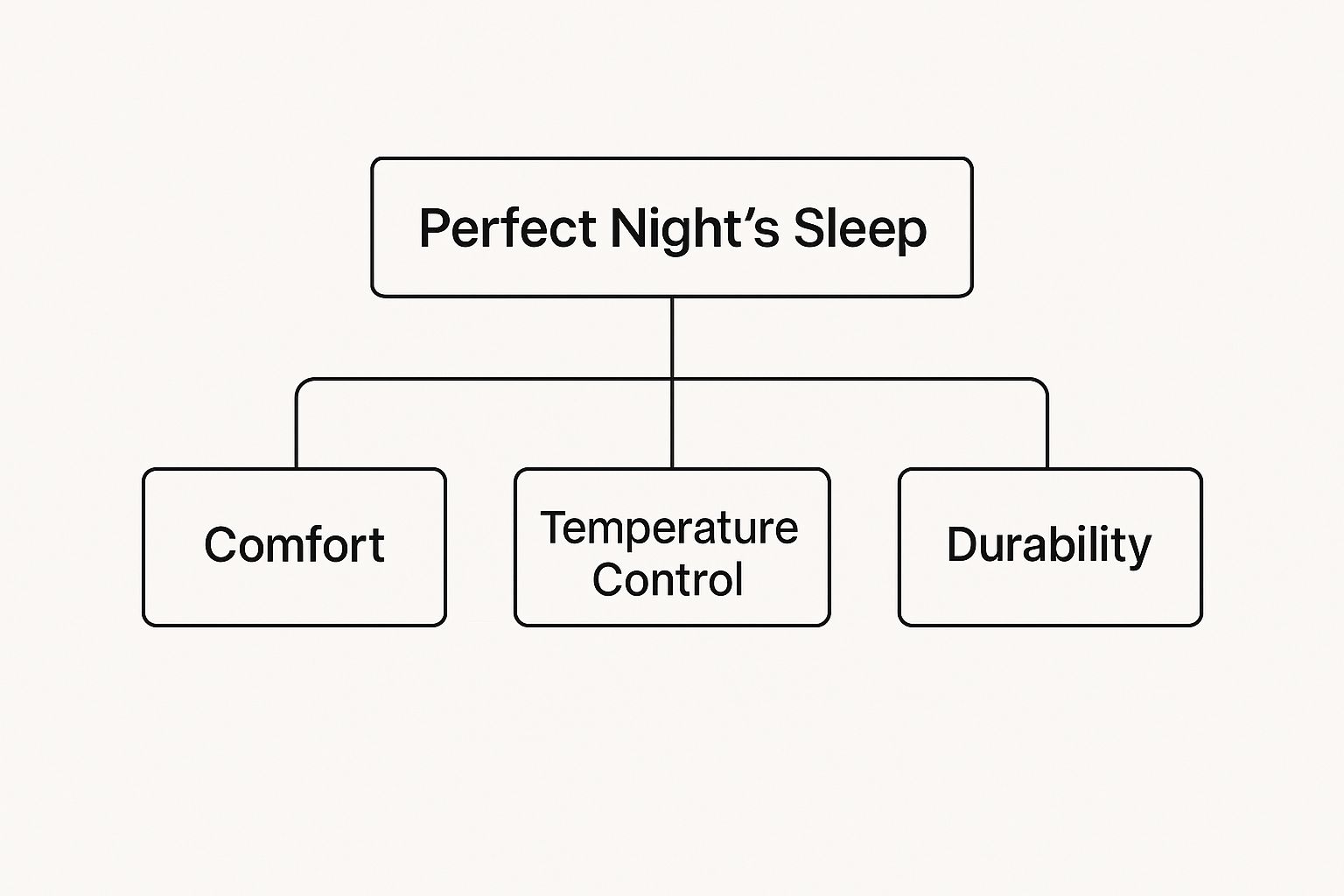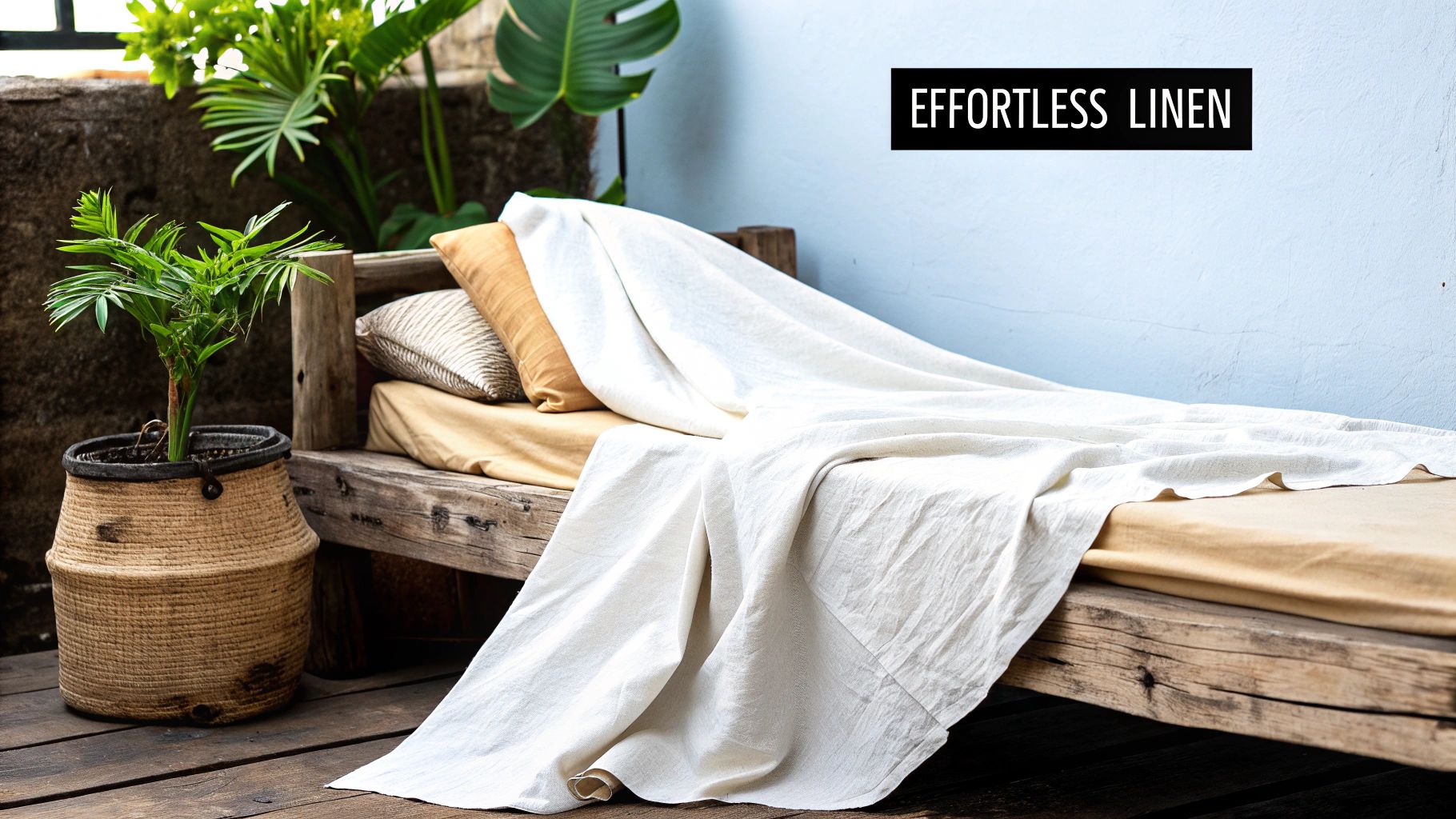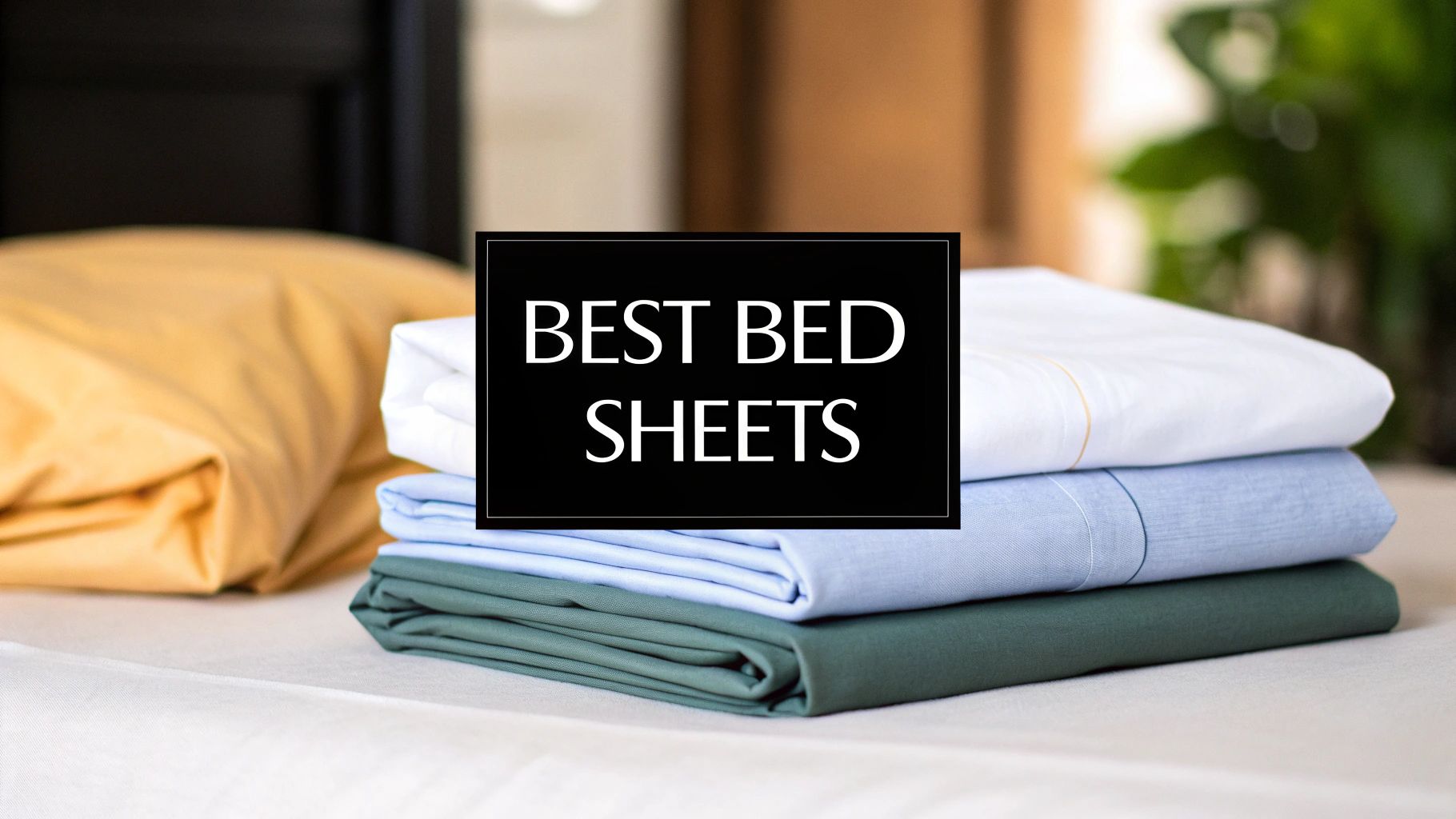When it comes to finding the best bed sheet material, there is no single perfect choice for everyone. What feels like a dream to one person might be less comfortable for another. The right sheets for you come down to your personal comfort, whether you are a hot or cold sleeper, and of course, your budget.
For many people, though, high quality cotton is just right, offering a fantastic balance of softness, breathability, and durability that is hard to beat.
How to Find Your Perfect Night's Sleep
Choosing new bed sheets is one of the quickest ways to transform your sleep. But with so many options out there, it is easy to feel a bit lost. This guide is here to cut through the confusion. We will explain why the material of your sheets is so important for your comfort, temperature, and getting a genuinely deep, restful night.
Think of this as your personal map to the world of bedding. We will explore everything from the crispness of classic cotton and the rustic charm of linen to modern fabrics like silky soft bamboo. By the time you are done, you will know exactly what to look for to suit your home and your unique sleep style.
Why Material Matters Most
The fabric touching your skin all night has a massive impact on your sleep quality. It directly affects how warm or cool you feel, whether your skin can breathe, and even how easily you can shift positions. Making an informed choice is not just a purchase; it is a real investment in your wellbeing.
The right material can be a game changer. A breathable fabric, for instance, can stop you from overheating, which is a very common reason for a restless night. This is a core part of what experts call good sleep hygiene, where you create an environment perfectly suited for rest. You can dive deeper into this with our guide on what is good sleep hygiene.
This infographic highlights the three pillars of a perfect night's sleep, all of which are directly influenced by your choice of bedding.

As you can see, the secret to fantastic sleep is finding that ideal balance of comfort, temperature control, and durability. It all starts with the fabric.
A Growing Appreciation for Quality
It is clear that here in the UK, we are paying more attention than ever to our home comforts. The bed linen market is a serious business, valued at around USD 1.82 billion in 2024. This growth is driven by a growing desire for high quality and organic fabrics as more of us invest in creating a comfortable, restorative home.
A truly great set of sheets is more than just a purchase. It is a commitment to better rest, calmer nights, and waking up feeling properly refreshed and ready for the day.
This guide will walk you through the pros and cons of each material, helping you find the one that feels like it was made just for you. Let's get started.
Why Cotton Is a Timeless Favourite
When you think of classic, comfortable bedding, chances are you are picturing cotton. It is the go to choice here in the UK for a very good reason. It offers a wonderful blend of softness, breathability, and durability that makes it a reliable favourite for just about any bedroom.
Its lasting popularity is no accident. Cotton simply delivers on the promise of a comfortable and refreshing night’s sleep, making it a staple in homes across the country.
The natural properties of cotton make it perfectly suited for the UK’s varied climate. The fibres are inherently breathable, allowing air to circulate freely. This helps to wick moisture away from your body, keeping you cool and dry on a mild summer evening, yet cosy and comfortable when the temperature drops. This natural temperature regulation is a key reason why it remains the best bed sheet material for so many.
This preference is clearly reflected in the numbers. In fact, cotton based sheets dominate the market, with bed linen making up an enormous 63.27% of the UK bed and bath linen sector in 2024. This overwhelming popularity highlights just how much we value the practical comfort that cotton provides. For anyone interested in the data, you can discover more insights about the UK linen market here.
Not All Cotton Is Created Equal
While "cotton" is a fantastic all rounder, the term itself covers a few different types, each with its own unique feel and qualities. Understanding these differences is the key to finding your perfect set. Think of it like choosing a good coffee, the origin and type of bean make all the difference to the final taste.
The main distinction comes down to the length of the cotton fibres, known as the staple. Longer staple fibres can be spun into finer, smoother, and stronger threads. This directly translates to softer, more durable, and more luxurious sheets that feel incredible against your skin.
Exploring the Different Types of Cotton
Let's break down the three main players you will come across when shopping. Each offers a different experience, so you can pick the one that best suits your needs and budget.
- Egyptian Cotton: Often seen as the absolute pinnacle of luxury, Egyptian cotton is grown in the unique climate of the Nile River Valley. It produces extra long staple fibres, resulting in sheets that are exceptionally soft, strong, and breathable. They are a true investment, becoming even softer with every wash.
- Pima Cotton: Another premium, long staple cotton, Pima is primarily grown in the USA. It offers a similarly soft and smooth feel to its Egyptian counterpart, with a lovely, subtle sheen. It is a fantastic alternative if you want a touch of luxury that is built to last.
- Upland Cotton: This is the most common type of cotton used in bedding worldwide. Its fibres are shorter, which means the resulting fabric is not quite as soft or smooth as its long staple cousins. However, it is still a durable and affordable option for everyday comfort.
The most important takeaway is this: longer fibres create a smoother and more durable fabric. This is why investing in sheets made from Egyptian or Pima cotton can provide a far more luxurious sleep experience that lasts for years.
Putting these options side by side can make the choice a lot clearer.
Comparing Different Types of Cotton
This simple table breaks down the key differences to help you decide what is right for you.
| Cotton Type | Key Benefit | Ideal Sleeper | Average Lifespan |
|---|---|---|---|
| Egyptian | Unrivalled softness & strength | The luxury seeker | 10-15+ years |
| Pima | Premium softness & durability | Anyone wanting everyday luxury | 8-12 years |
| Upland | Affordable & widely available | The budget conscious shopper | 3-5 years |
This comparison highlights that while Upland cotton is a great practical choice, a step up to Pima or Egyptian can significantly elevate your comfort and the longevity of your bedding.
And if you are curious about how cotton stacks up against other natural fibres, you might find our detailed comparison between linen and cotton sheets very helpful.
What About Thread Count?
Ah, thread count. It is one of the most talked about, and most misunderstood, aspects of buying sheets. It simply refers to the number of horizontal and vertical threads woven into one square inch of fabric. For years, marketing has told us that a higher number automatically means better quality, but that is only part of the story.
A very high thread count, like 1000 or more, can sometimes be a red flag. It is often achieved by twisting thinner, lower quality threads together to inflate the number. This can result in a dense, heavy fabric that is actually less breathable and less durable.
A better approach is to look for a moderate thread count, typically between 200 and 600, made from high quality, long staple cotton.
The quality of the fibre and the skill of the weave have a much bigger impact on how the sheets actually feel. A 300 thread count sheet made from premium Egyptian cotton will feel far superior and last much longer than a 1000 thread count sheet made from short staple Upland cotton. The secret is to focus on the material first, then consider the thread count as a secondary factor.
Understanding How Weave Changes Everything
It is not just the type of cotton that dictates how your sheets feel; the way those threads are woven together plays a massive role, too. Think of it like baking a cake. Two bakers can start with the exact same flour, but how they mix and prepare it results in completely different textures. In the world of bedding, the weave is what gives the final fabric its unique personality.
Getting to grips with the weave is your secret to finding the perfect feel. It is what determines whether your sheets are crisp and cool or silky and smooth. Even with the same high quality material, a different weave can completely alter your sleep experience, making it a crucial factor in choosing the best bed sheet material for your home.

Percale: The Cool and Crisp Classic
If you love that feeling of slipping into a freshly made bed at a smart hotel, you will adore percale. This weave uses a simple one thread over, one thread under pattern, which creates a light, breathable fabric with a crisp, matte finish. It is the perfect choice for anyone who tends to get a bit warm at night.
The structure of the percale weave allows air to circulate freely, helping to keep you cool and comfortable all night long. Because it is so breathable, it never feels stuffy or heavy, even during milder weather.
Percale is celebrated for its cool to the touch feel. It offers a refreshing, almost airy sensation that is especially welcoming after a long day. This makes it an excellent option for summer bedding or for year round comfort if you are a "hot sleeper".
It is worth noting that this crispness can also mean percale sheets are more prone to wrinkling. For many, though, that slightly lived in look is part of their relaxed charm.
Sateen: The Silky, Smooth Indulgence
If your idea of heaven is bedding that feels buttery soft and drapes beautifully, then sateen is for you. This weave uses a one thread under, three or four threads over pattern. This technique exposes more of the thread’s surface, resulting in a fabric that is exceptionally smooth with a subtle, elegant sheen.
Sateen feels incredibly soft and luxurious against the skin. Its slightly heavier weight and silky texture provide a wonderful sense of cosiness, making it ideal for those who prefer a warmer, more cocooning feel.
Unlike the crispness of percale, sateen has a fluid drape that hangs beautifully on the bed, giving your bedroom a polished and inviting look. While it is naturally more resistant to wrinkling than percale, its delicate surface means it can be slightly less durable over the long term.
For those who want to get the details just right, understanding the balance between weave and thread count is key. You can learn more about the best thread count for sheets in our dedicated guide, which will help you make a truly informed choice.
Other Weaves to Know
While percale and sateen are the most common choices, you might come across a few others. Each offers a distinct feel and set of benefits.
- Twill: This weave has a visible diagonal pattern, just like your favourite pair of jeans. It is very durable and drapes well, making it a practical choice that can withstand plenty of wear and washing.
- Jersey: If you love the soft, stretchy comfort of a well worn t-shirt, you will enjoy jersey sheets. Made from knitted cotton, they are incredibly soft and casual, perfect for a relaxed and cosy bedroom.
By matching the right weave to your personal comfort preference, you are one step closer to creating your perfect sleep sanctuary.
The Effortless Charm of Linen Bedding
If you are dreaming of a bedroom that feels relaxed, stylish, and effortlessly chic, linen might just be your perfect match. Sourced from the fibres of the resilient flax plant, linen bedding brings a unique, earthy texture to your space that feels both rustic and incredibly sophisticated. It is a material that does not try too hard, yet always manages to look wonderful.
The real magic of linen, though, lies in its exceptional breathability. The hollow nature of its fibres allows air to circulate freely, making it one of the best materials for staying comfortable all year round. On a warm summer evening, linen wicks moisture away from your skin, leaving you feeling cool and dry. Come winter, it does the opposite, acting as a natural insulator to keep you comfortably warm and cosy.

A Material That Gets Better with Age
Unlike many fabrics that fade or wear out over time, linen has the remarkable quality of improving with every single wash. Brand new linen sheets often have a slightly crisp texture, but with use and gentle laundering, they transform, becoming incredibly soft and supple. This evolution makes them a fantastic long term investment for your home.
Linen is also famous for its impressive durability. In fact, it is considered one of the strongest natural fibres in the world. This means a high quality set of linen sheets can last for many years, eventually becoming a cherished part of your home.
This enduring appeal and incredible comfort are central to the experience of sleeping in https://morganandreid.com/blogs/journal/luxurious-bed-linens. A great set of sheets should feel like an old friend, growing softer and more inviting over the years, which is exactly what linen delivers.
One of the first things people ask about is linen's tendency to wrinkle. Instead of seeing this as a flaw, it is best to embrace it as part of linen’s natural, laid back character. That slightly rumpled look is precisely what gives linen its signature effortless charm.
Perfect for Sensitive Skin and Warm Sleepers
Beyond its beautiful appearance and feel, linen offers some brilliant practical benefits, especially for those with sensitive skin or who tend to overheat at night. It is naturally hypoallergenic, which means it is far less likely to cause irritation, making it a wonderfully gentle choice for the whole family.
Its moisture wicking properties are another huge plus. Linen can absorb a significant amount of moisture without ever feeling damp, which helps to keep your skin feeling fresh and dry throughout the night. This makes it an ideal choice for anyone who struggles with night sweats or simply prefers a cooler sleep environment.
Here is a quick look at why linen stands out:
- Exceptional Breathability: Keeps you cool when it is warm and warm when it is cool, making it ideal for year round comfort.
- Gets Softer Over Time: Each wash enhances its softness, turning it from crisp to wonderfully supple.
- Incredibly Durable: As one of the strongest natural fibres, linen sheets are a long lasting investment.
- Hypoallergenic Properties: Naturally gentle on the skin, making it a fantastic option for those with allergies or sensitivities.
- Effortless Style: The characteristic wrinkles give it a relaxed, lived in look that is both stylish and inviting.
While linen often comes with a higher price tag than cotton, its longevity and unique comfort make it a worthwhile investment. Choosing linen is about more than just buying bedding; it is about creating a peaceful and restorative sanctuary where you can truly relax and unwind.
Exploring Modern and Practical Alternatives
Beyond the classic comfort of cotton and linen lies a world of modern fabrics, each offering brilliant solutions for comfort, practicality, and sustainability. These are not just trendy alternatives; they are thoughtfully designed materials that cater to specific needs, whether you are after a silk like feel or a budget friendly, durable option for a busy household.
Stepping into these newer materials can feel like a fantastic discovery. You might just find that the perfect bedding for your home is a fabric you had not even considered, one that perfectly matches your lifestyle and preferences.
The Silky Softness of Bamboo
If you dream of sheets that feel incredibly soft and smooth, almost like silk, then bamboo derived fabrics are a wonderful choice. They are celebrated for their luxurious feel and beautiful drape, which instantly gives any bed an elegant, inviting look.
But the appeal goes far beyond just softness. Bamboo fabrics are exceptional temperature regulators. They are highly breathable and brilliant at wicking moisture away from your skin, helping to keep you cool and dry on warmer nights. This makes them a fantastic option for anyone who tends to sleep hot.
On top of that, these materials have several other practical advantages:
- Hypoallergenic: Bamboo is naturally gentle, making it a soothing choice for people with sensitive skin or allergies.
- Sustainable Choice: As a fast growing plant, bamboo is often considered a more environmentally friendly resource compared to some others.
- Durable Fabric: Despite its delicate feel, bamboo fabric is surprisingly strong and can last for years with the right care.
Think of bamboo sheets as a smart, sustainable alternative to silk. They offer that same sense of luxurious indulgence but come with the added benefits of excellent temperature control and a more accessible price point.
The Practicality of Microfibre
For many homes, especially those with children or pets, practicality is just as important as comfort. This is where synthetic options like microfibre truly shine. Made from finely woven fibres, usually polyester, microfibre sheets are designed for real life.
Their main advantage is their incredible durability and ease of care. Microfibre is highly resistant to staining, shrinking, and wrinkling, which means less time spent on laundry and ironing. You can wash and dry them with minimal fuss, and they come out looking smooth and ready for the bed every time, a real lifesaver for busy families.
They are also one of the most budget friendly options you can find. This allows you to have multiple sets on hand without a significant investment, which is always useful for guest rooms or children’s beds that need frequent changes.
A Balanced View on Synthetics
Of course, it is important to be realistic about the trade offs. While microfibre is wonderfully practical, it is less breathable than natural fibres like cotton or linen. The same tight weave that makes it so durable can also trap heat, which may not be ideal if you tend to sleep warm.
Still, for a child’s first bed, a spare room, or simply as a durable, easy care option, microfibre is hard to beat. It serves a specific purpose brilliantly, offering a dependable solution when your priorities are durability and convenience. For those seeking natural alternatives, our guide on why you might choose organic bed linens offers some lovely insights.
While traditional materials like cotton still hold a massive 46.36% of the UK home textile market, these innovative fabrics are certainly gaining ground. Projections show that smart bedding with features like advanced moisture wicking is set to grow significantly. However, the high standards required for things like OEKO-TEX certification mean that premium natural fibres remain a trusted benchmark for quality. You can read the full research about the UK home textile market to learn more.
Tying It All Together: Your Bedding Questions Answered
We have covered a lot of ground in the world of bed sheets, but you might still have a few questions lingering. That is completely normal. This last section is here to clear up some of the most common queries we hear, giving you that final piece of the puzzle so you can choose your next set of sheets with total confidence.
Let’s get those final questions sorted.
What is the Best Bed Sheet Material for Hot Sleepers?
If you are someone who tends to overheat at night, the right material can make all the difference. Your goal should be breathability above all else.
Linen is the undisputed champion here. Its natural, long fibres create a highly breathable fabric that allows air to circulate freely. It also has a remarkable ability to wick moisture away from your skin, so you stay cool and dry even on the warmest nights.
Another excellent choice is cotton percale. Think of the cool, crisp feel of a classic hotel sheet, that is percale. Its straightforward weave does not trap heat, making it a reliable go to for warmer temperatures. Bamboo derived fabrics are also a solid contender, known for their silky feel and cooling properties.
Does Thread Count Really Matter That Much?
For years, thread count was the number one thing people looked for, but the truth is a bit more nuanced. It is certainly a factor, but it is definitely not the only thing that matters. A quality set of sheets will typically have a thread count between 200 and 800.
What is far more important is the quality of the fibre itself and the type of weave. A 400 thread count sheet made from superior, long staple Egyptian cotton will feel infinitely better and last much longer than an 800 thread count sheet made from shorter, lower quality cotton fibres. Do not let a high number fool you; focus on the source material first.
How Can I Make My New Sheets Last Longer?
A little bit of care goes a long, long way in preserving the life and feel of your new bedding. It is simpler than you might think.
- Wash Cool: Always opt for a cool or warm wash. Hot water is harsh on natural fibres and can cause them to weaken and shrink over time.
- Go Gentle on Detergent: Steer clear of harsh detergents and fabric softeners. These can leave a residue on the fibres, which actually reduces the material’s natural softness and breathability.
- Dry with Care: Tumble dry on a low heat setting. To keep wrinkles at bay, try to take them out of the dryer as soon as the cycle finishes.
- Rotate Your Stock: It is a great idea to have two or three sets of sheets you love. Alternating between them spreads out the wear and tear, meaning each set will last significantly longer.
Are Expensive Bed Sheets Actually Worth It?
Honestly? In most cases, yes. While the initial cost is higher, investing in premium materials like genuine linen or Egyptian cotton really does pay dividends.
They do not just offer a better night’s sleep from day one; they are also far more durable and often get softer and more comfortable with every wash. Think of it less as a purchase and more as a long term investment in your own comfort and well being.
At Morgan and Reid, we believe that beautiful, comfortable bedding is the foundation of a happy home. We pour that passion into every collection we create. When you are ready, we would love to help you find the perfect sheets and comforters for you and your family. Discover your perfect night's sleep with us today.



Share:
Find Your Perfect Fluffy Comforter for Cosy Sleep
What Is Sateen and Is It Right for Your Bedding?